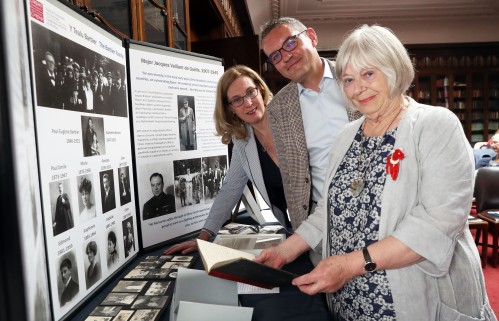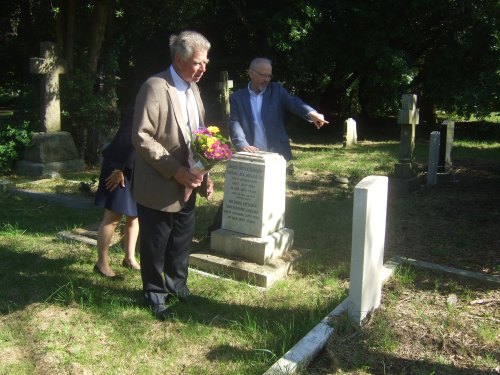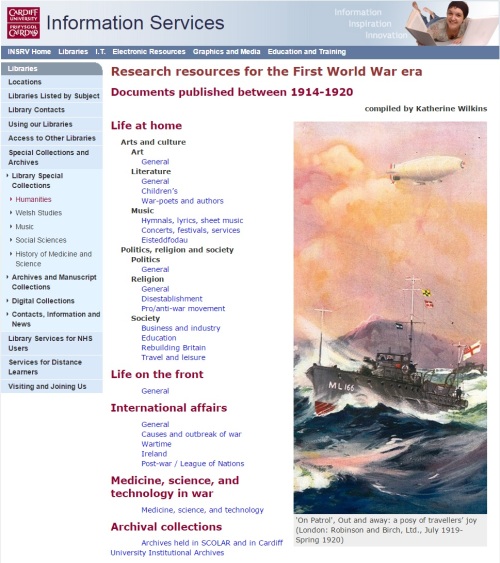In this guest post, Katy Stone, who has been cataloguing the Barbier archive as part of a CUROP student intern project, keeps us up to date with some more fascinating insights into the Barbier family, and what their archive can tell us about key international events at the end of the nineteenth century.
In this update I’d like to share with you my discoveries about international events as revealed through the eyes of the Barbiers. Over the summer I have delved through boxes of intriguing letters dating from 1898-1904 and these have shed light on various international controversies, tensions and conflicts that shook the world during the family’s time in Cardiff. Of all the Barbier sons, the archive suggests that Georges took the most interest in international current affairs, noting he would “very much like to be more up to date”.

Georges Barbier
The Dreyfus Affair

In 1898, Georges often writes about the Dreyfus Affair, a political scandal which divided the French Third Republic from 1894 until 1906. The controversy centred on the question of guilt or innocence of a Jewish army captain, Alfred Dreyfus, convicted of treason for selling military secrets to the Germans in December 1894, but finally pardoned on 19 September 1899. French citizens were torn between those who supported him (Dreyfusards) and those who thought he was a traitor. Georges presents the situation in France as “very bad”. His letters reveal that he clearly supported Dreyfus, referring to those who condemned him as “pigs”, and adding that if Dreyfus’s innocence could be proved, he would not complete his military service, revealing his disgust with the army who took an anti-Dreyfus position. Euphémie Barbier also referred to the scandal in a letter dated 1898, hoping that “spirits will calm, and we won’t have a war”. Isabelle Bornet placed high hopes in the new French President, Émile Loubet, writing in 1899 that “France will soon be rid of this affair which it has suffered for a long time”.
The Spanish-American War
Georges also wrote in some detail about the Spanish-American War, fought between America and Spain between 21 April 1898 and 13 August 1898. Hostilities began after an explosion sank the American battleship USS Maine, which was sent to protect US citizens and property after anti-Spanish rioting in Havana Harbour in Cuba that led to US intervention in the Cuban War of Independence from Spain, which began in February 1895. The conflict ended Spanish colonial rule in the Americas and the US acquired territories in the western Pacific and Latin America. I was struck by his personal perception that England supported America simply because they were the “same race and origin”. Considering this, Georges’s support for the Spaniards and his proclamation that “it would be a great pleasure to see them [the Americans] receive a good beating”, surprised me. Perhaps Georges’s support for Spain stems from his European heritage. Euphémie was also supportive of the Spaniards, describing them as “patriotic”, after telling of one civilian who sold everything he had to support the war effort, later receiving an honourary title. Again, her opinions may be biased due to the Barbier family’s European roots.

Euphémie Bornet
Anglo-French relations preoccupy Paul Barbier fils in his letters dated around 1898. He discusses the Fashoda Incident, which was the climax of imperial territorial disputes between Britain and France in Eastern Africa: “The question of Fashoda seems rather serious, although it is probably less serious than it looks”. I was fascinated by his thoughts about the attitudes of the press in London, and especially the Daily Mail, which he implies was perhaps not the most reliant source of information regarding the conflict and its “apparent gravity“. Later, he states it was obvious there would be war “if England insists on the pure and simple reminder of the Commanding Officer to precede all negotiations”, demanding his father to “ask the Consul in all cases what is my duty in this case, if it is absolutely the same as in the case of war with Germany, i.e. my immediate return to the regiment”. Paul’s offer to step in suggests that he was frustrated by the unwillingness of the Commanding Officer to take a leading role in negotiations. Perhaps to reassure Paul, his mother Euphémie related that his father believed “the Fashoda affair will calm itself”.
Other letters reference the Second Boer War, particularly the Siege of Ladysmith in Natal between 2 November 1899 and 28 February 1900. The Second Boer War was fought between the British Empire and the two Boer states, the South African Republic and the Orange Free State, over the Empire’s influence in South Africa. In a letter of 1900, Marie mentions demonstrations in Cardiff for the relief of Ladysmith, which occurred during nightfall on 28 February 1900, when the siege was lifted. Marie notes somewhat ironically, that “all the young people at the Docks have a break this afternoon”. This perhaps reflects a feeling of antipathy towards those protesting. I would be interested to see how much contemporary documentation exists about this demonstration beyond the Barbier archive, if any.

Marie Barbier
In short, some material in the Barbier Archive makes compelling reference to international affairs, contributing greatly to our understanding of tensions throughout the period by unveiling contemporary interpretations that may be missed by history textbooks, particularly as perceived in Cardiff. I found the parallels between the reporting on current affairs at the time, and current affairs today including concerns over the neutrality of reporting, particularly interesting. I was most drawn however to the human elements within the text, and the family connections strengthened through these letters as they kept each other up to date with ongoing affairs.



 Passionate about archaeology as well as
Passionate about archaeology as well as 




















